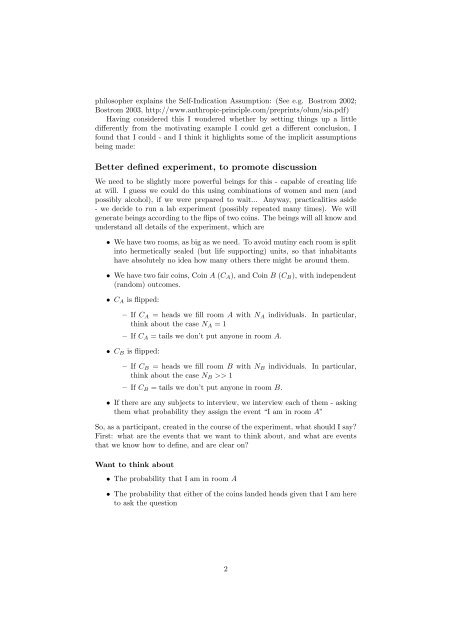many observers - Niall Cardin
many observers - Niall Cardin
many observers - Niall Cardin
Create successful ePaper yourself
Turn your PDF publications into a flip-book with our unique Google optimized e-Paper software.
philosopher explains the Self-Indication Assumption: (See e.g. Bostrom 2002;<br />
Bostrom 2003, http://www.anthropic-principle.com/preprints/olum/sia.pdf)<br />
Having considered this I wondered whether by setting things up a little<br />
differently from the motivating example I could get a different conclusion, I<br />
found that I could - and I think it highlights some of the implicit assumptions<br />
being made:<br />
Better defined experiment, to promote discussion<br />
We need to be slightly more powerful beings for this - capable of creating life<br />
at will. I guess we could do this using combinations of women and men (and<br />
possibly alcohol), if we were prepared to wait... Anyway, practicalities aside<br />
- we decide to run a lab experiment (possibly repeated <strong>many</strong> times). We will<br />
generate beings according to the flips of two coins. The beings will all know and<br />
understand all details of the experiment, which are<br />
• We have two rooms, as big as we need. To avoid mutiny each room is split<br />
into hermetically sealed (but life supporting) units, so that inhabitants<br />
have absolutely no idea how <strong>many</strong> others there might be around them.<br />
• We have two fair coins, Coin A (C A ), and Coin B (C B ), with independent<br />
(random) outcomes.<br />
• C A is flipped:<br />
– If C A = heads we fill room A with N A individuals. In particular,<br />
think about the case N A = 1<br />
– If C A = tails we don’t put anyone in room A.<br />
• C B is flipped:<br />
– If C B = heads we fill room B with N B individuals. In particular,<br />
think about the case N B >> 1<br />
– If C B = tails we don’t put anyone in room B.<br />
• If there are any subjects to interview, we interview each of them - asking<br />
them what probability they assign the event “I am in room A”<br />
So, as a participant, created in the course of the experiment, what should I say<br />
First: what are the events that we want to think about, and what are events<br />
that we know how to define, and are clear on<br />
Want to think about<br />
• The probability that I am in room A<br />
• The probability that either of the coins landed heads given that I am here<br />
to ask the question<br />
2


